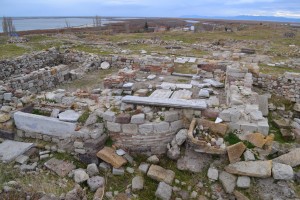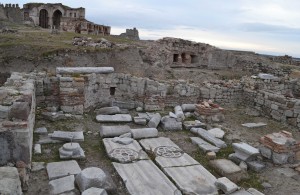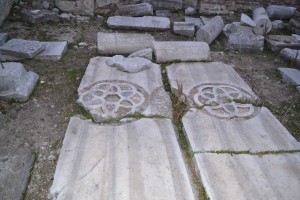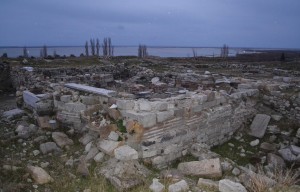Archive for March 1st, 2016
The remains of the Church of Hagios Gregorios Neokaiserias lie in the centre of Enez Kalesi, the acropolis of Ainos. Like most churches in the area, Hagios Gregorios did not survive the Greek-Turkish war. Photographs from 1902 and 1908 show a small cross-in-square church with a high drum and a slightly curved dome of a type unknown in Constantinople but characteristic of later churches in Thessaloniki or Bulgaria.
The style of brickwork suggests an origin in the late eleventh or early twelfth century but the building was subject to many later additions and reworkings. A sizeable annex on the south enlarges the floor plan considerably. This was a single-naved church with three sarcophagi beneath the marble floor. Two major floor section that remain in situ were made with a technique known as opus sectile in which thin pieces of decorative material are inlaid into the base material in a decorative pattern. The picture on page 842 of Ousterhout (2011) shows that the opus sectile section has experienced significant deterioration since 1979 (not 1908, as the caption indicates).
Moysidou, J (ed) (2007) Thrace – Constantinople: Georgios Lambakis’s Journey (1902) Exhibition Catalogue. Hellenic Ministry of Culture. Available online at: http://www.aol.org.gr/sylloges/dimosieymata/katalogos-thraki/katalogos-thraki.pdf Accessed Feb 23rd 2016.
Ousterhout, R. and C. Bakirtzis (2007) The Byzantine Monuments of the Evros/Meriç Valley. European Centre for Byzantine and Post-Byzantine Monuments. Thessaloniki. Available online at http://issuu.com/ekbmm.gr/docs/evros_meric Accessed 14th Jan 2016
Ousterhout, R. (2011) The Byzantine Architecture of Thrace: The view from Constantinople. Byzantinische Forschungen: Internationale Zeitschrift für Byzantinistik. W. Kaegl Jr (ed) Verlag Adolf M. Hakkert, Amsterdam. Available online at: https://www.academia.edu/4462861/The_Byzantine_Architecture_of_Thrace_The_View_from_Constantinople Accessed Feb 23rd 2016





